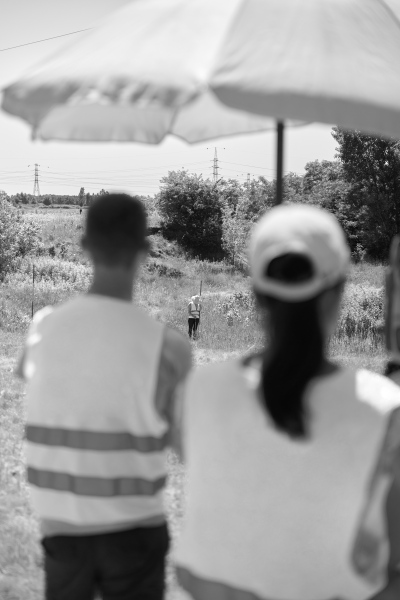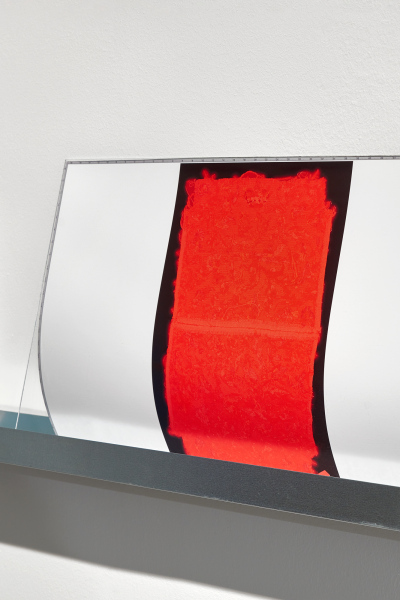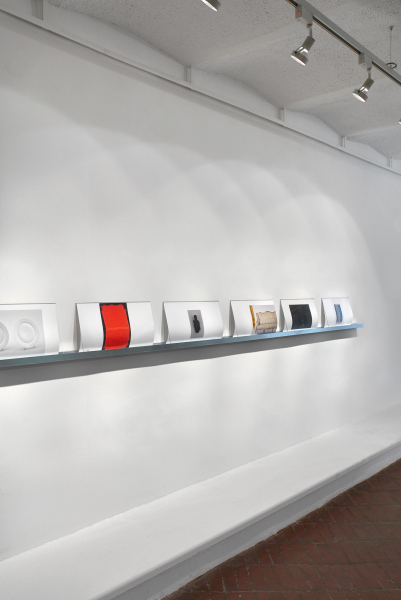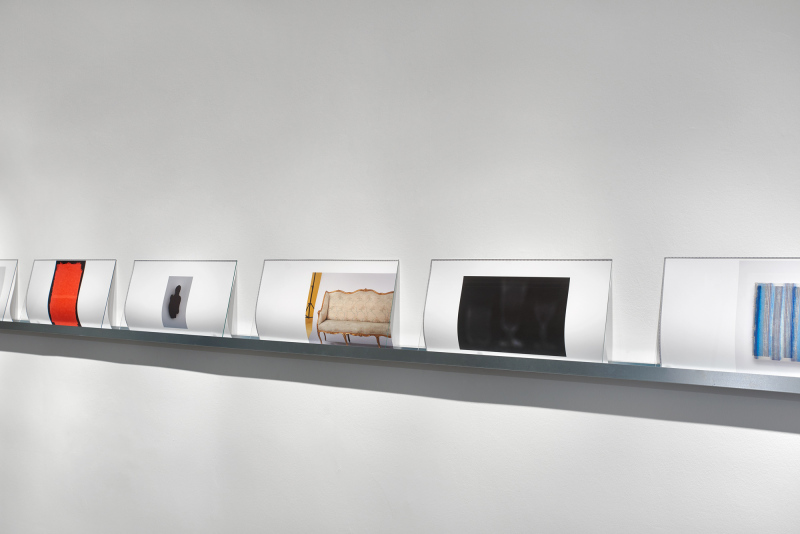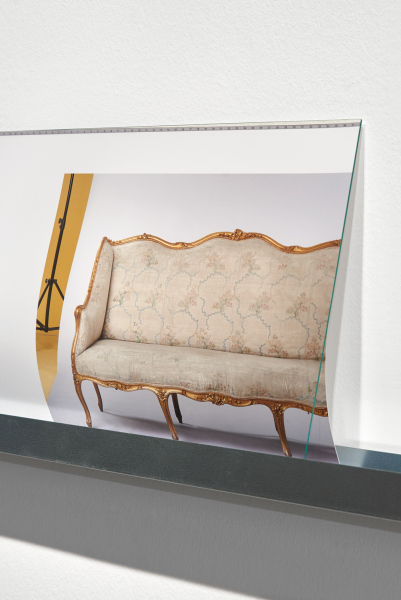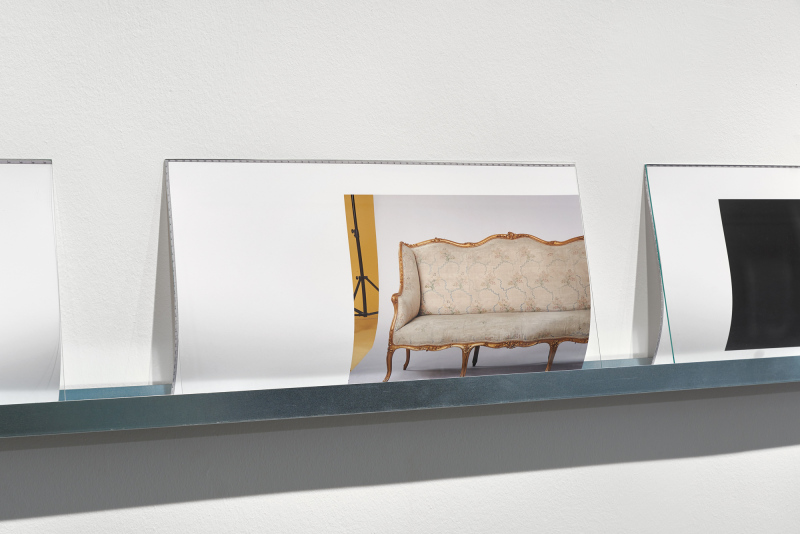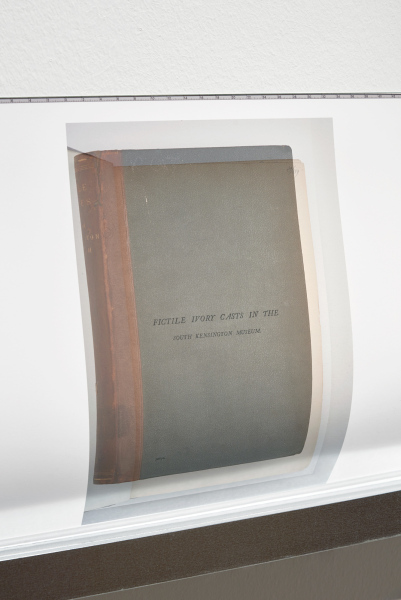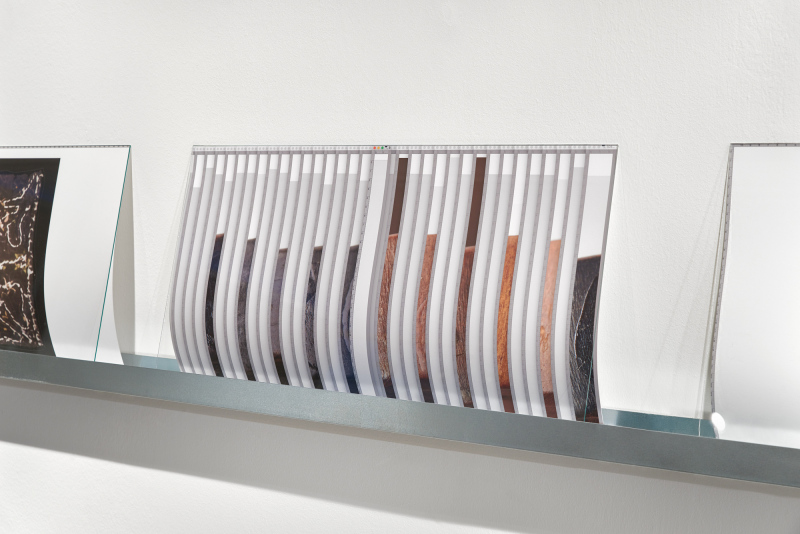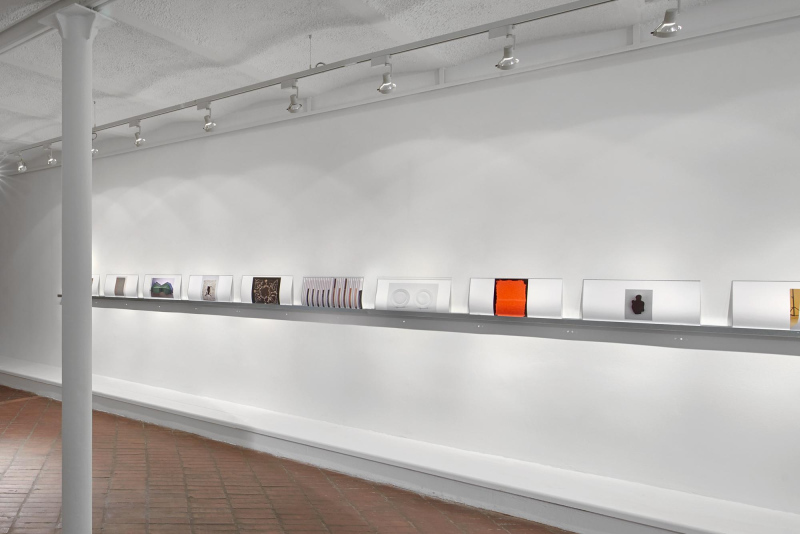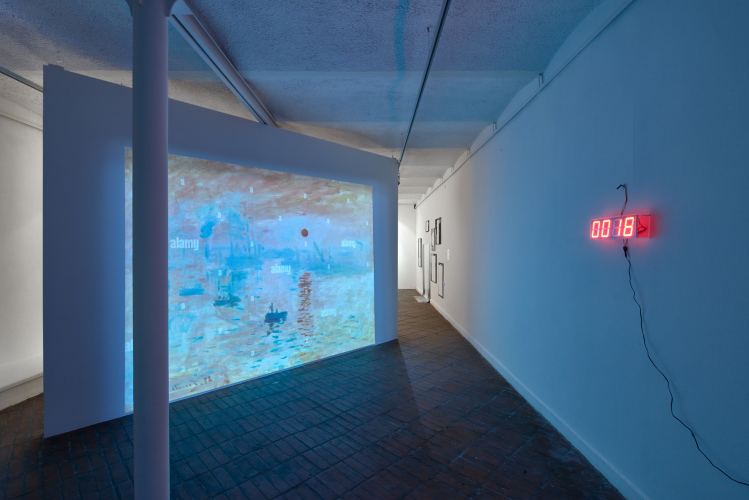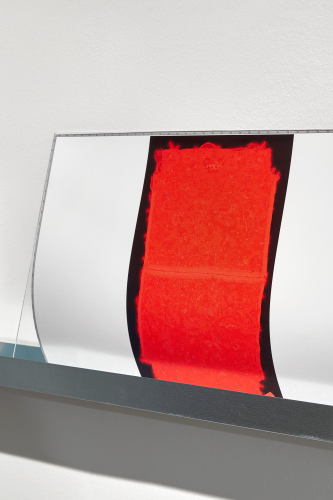Situations
2023-2024
Situations is a research-based, medium-reflexive photography project that focuses on a hidden side and aspect of photography. It deals with images, or more specifically image fragments, that were never intended to be presented or published.
I started the project in preparation for my exhibition at the Ferenczy Museum in Szentendre, by studying the museum’s photo archive. The institution’s collection has been systematically documented and reproduced since its foundation in the 1950s. Reproductions of the artworks in numerous publications have spread throughout the country and abroad. However, during the enlargement of the negatives, only the part depicting the artwork was enlarged, the other parts were covered up, so they remained visible only on the negatives.
Contrary to the photographers original intention, I was interested in revealing the parts of the images that were considered “useless”. I started searching for negatives that, in addition to the reproduction of the artwork, also preserved some pictorial information about the conditions of the photo taking. On the selected and scanned photos, I covered the primary object of the image (the artwork), highlighting the otherwise invisible image areas. Due to the new pictorial situation, details deemed unnecessary are valued: a spontaneous hand gesture, a piece of clothing from the period, or an identifiable part of a building in the background. All details pointing to the human factors behind reproduction photography thought to be impersonal.
— HU —
Szituációk, 2023-2024
Az 1951-ben alapított szentendrei Ferenczy Múzeum gyűjteményét a kezdetektől szisztematikusan dokumentálják. Az azóta keletkezett különböző fotóreprodukciók számos könyvben, albumokban és egyéb publikációkban jelentek meg.
A múzeum fotóarchívumában olyan negatívokat keresek, amelyek a műtárgy – később kivágva lenagyított – reprodukcióján kívül a fotó készítésének körülményeiből is megőriztek valamilyen képi információt. Az eredeti fényképek valódi tárgya, a műtárgy eltakarásával a korábban nem látott, feleslegesnek vélt részletek kerülnek középpontba. Benyúló kezek, szokatlan helyszínválasztás, korabeli ruhadarabok, mind egy-egy olyan részlet amely a személytelennek hitt reprodukciós fotózás mögött meghúzódó emberi tényezőkre utal.

From the series 'Situations', 2023
Photo © Benedek Regős
Butterfly Effect, 2023
single-channel video, light meter
egycsatornás videó, fénymérő
The work 'Butterfly Effect' based on the collection of different online reproductions of Monets' painting »Impression. The rising sun«. The well-known artwork, depicting the morning sight of the port of Le Havre was painted by Monet in 1872, but it was first presented two years later at so called "First Impressionist Exhibition" organized by the photographer Nadar, in his Paris studio. The art-historcial significance of the painting is proved by the fact that its title gives rise to the name of the new artistic endeavor (impressionism) and its representatives (impressionist), who started to think differently on depiction. Instead of faithful and detailed copying of the subject, they sought to convey sensual impressions. (The appearance of photography may also have played a major role in this). With the title choice, Monet wanted to emphasize this change of approach.
Today the »Impression, the rising sun« can be found on the Internet in dozens of different color, tonal and resolution reproductions. Without knowing the original, it is impossible to determine which one can be considered the same. So we can only guess by comparing the versions. In my work, I deal with the increasingly common dilemma of visual reproductions, reproducibility and image rendering and the trust placed in them in the era of improved imaging. The pulsating effect of the projection reflects colours on the white wall and can also be detected on the display of a continuous light meter, referring to the effective consequences of initially insignificant but later significant differences.
HU
A "Pillangóhatás" című munka Monet: "Impresszió. A felkelő nap" c. festményének különféle, online elérhető fotó reprodukcióin alapul. Az eredeti, Le Havre kikötőjének reggeli látványát ábrázoló mű 1872-ben készült, de csak két évvel később lett először bemutatva a korszak közismert fotográfusa, Nadar műtermében rendezett ún. "első impresszionista" kiállításon. A festmény művészettörténeti jelentőségét bizonyítja, hogy címéből ered az új művészeti törekvés (az impresszionizmus) és annak képviselőinek (impresszionisták) elnevezése. Ekkor történt meg ugyanis az a radikális, – az ábrázolásmódban bekövetkezett – fordulat, amely a korábbi akadémikus gyakorlat – a téma elelmeinek hű és részletes másolása – helyett, az érzéki benyomások átadására törekedett. Ebben pedig feltehetően nagy szerepe volt a fotográfia elterjedésének is. Monet a címválasztással ezt a szemléletváltást akarta kihangsúlyozni.
Az „Impresszió. A felkelő nap” ma az interneten több tucat, különböző színhatású, tónusú és felbontású reprodukcióban szerepel. Ezért az eredeti ismerete nélkül képtelenség megállapítani, hogy melyik tekinthető az azzal leginkább megegyezőnek. A változatok összehasonlításával tehát csak találgathatunk. Munkámban arra az egyre általánosabb dilemmára keresem a választ, hogy mit is jelent, hogyan működik és mit eredményezhet a fotografikus reprodukálás, reprodukálhatóság, a képi "visszaadás" és az abba fektetett bizalom az egyre tökéletesebbre fejlesztett képalkotás korában. A vetítés pulzáló fényhatása a fehér falra állandóan változó színtónusokat reflektál ami egy folyamatos fénymérő kijelzőjén is detektálható, utalva a kezdetben jelentéktelennek tűnő, de később meghatározó jelentőségű eltérések effektív következményeire.
Four Days of Solitude, 2020
2020
The year of 2020 is likely to be one of the important years in history. The pandemic situation caused by the coronavirus has affected society around the world, and changed the rythm of life for all. People were forced to retreat, to stay and to change their always moving position into sitting in front of monitors, the outputs of virtual channels. Social distancing and takeaway food has become the new norm. A crazy time with disposable white plastic food boxes.
The four CGI-like details depict the same plastic foodbox, but in four different lighting conditions, demonstrating the presence of change, even in the most seemingly unchanged situation.

Construction, 2020
laser print
Project with Orsolya Kaincz for CAPAZINE - LET'S DANCE
In the course of the CAPAZINE workshop, we were thinking about a project in which photography and music would be interdependent in a situation where the auditive element is closely connected with a static visual element (eg. a photograph). The most direct connection we could find was sheet music.
Following the traditions of the graphical sheet music, we created a photographic sheet music, which the musicians used as a score. As opposed to the traditional notation, the performers do not read the sheet music, but observe it, and transform their visual impressions into music. During this process, the performers have a much greater measure of freedom in the created sound as the score does not include concrete instructions regarding the timing or the diction of the music, and it does not even determine the instruments to use for creating the sounds.
For the photographs, we built an environment from construction materials, which were selected based on their form, material, quality, texture, and size. This is how the images depict plexilglass, metal, expanded polystyrene, raw wood, foam rubber, plastic cable duct, and universal foam. The effects resulting from the physical characteristics of these materials are complemented via the dynamics created by the lighting, the tension of the composition, and the random fragmented shapes appearing during the digital postprocessing.
Konstrukció
lézer nyomat
(Kaintz Orsolyával közös projekt a második CAPAZINE-ban.)
A Capazine műhelymunka során egy olyan projektben gondolkodtunk, amelyben a fotográfia és a zene egymás függvénye egy olyan helyzetben, ahol az audiális elem szorosan összekapcsolódik egy statikus vizuális elemmel. A legközvetlenebb kapcsolatnak a kottát találtuk. A grafikus kották hagyományait követve fotografikus kottát hoztunk létre, amit a zenészek partitúraként használtak. A hagyományos notációval szemben az előadók a kottát nem olvassák, hanem szemlélik, és vizuális benyomásaikat alakítják zenévé. Ebben a folyamatban az előadóknak jóval nagyobb a szabadsága a létrehozott hangzásban, hiszen a partitúra nem tartalmaz konkrét utasításokat a zene időtartamára vagy az előadás módjára vonatkozóan, sőt arra sem, hogy milyen eszközökkel hozzák létre a hangzást. A fotózáshoz egy environmentet építettünk különböző, építkezéskor használatos anyagokból, melyek kiválasztásánál fontos szempont volt a forma, az anyagminőség, a textúra és a méret. Így jelenik meg a képeken a plexi, a fém, a hungarocell, a nyers fa, a habszivacs, a műanyag kábelcső vagy a purhab. Az anyagok fizikai tulajdonságaiból fakadó hatásához járul hozzá a világítással létrehozott dinamika, a kompozíció feszültsége és a digitális utómunka során előidézett véletlen formarészek megjelenése.

© Benedek Regős
Atlas
2017
pigment print
99 x 176 cm

Offset, 2019
2019
projection, shelf, archive photographs
„Two hands of a statue; in two kinds of position.
The left clanched in fist, the right palm outstretched.”
The work ‚Offset’ focuses on a statue of Lenin erected in 1970 on the main square of Dunaújváros, the hungarian industrial city, built from 1949. The bronze sculpture formed by István Kiss - one of the most popular and occupied sculptor of the era - was dismantled 20 years after its unveiling in April 1990. For a long time in the 90’s it was lying covered at the site of the city management company till 2003, when it was re-erected under the arches of the local museum. It is still there, in the neighborhood of the locally-found Roman stone fragments.
This statue was erected as an indispensable representation of the dominant ideology, as many of the similar examples from the main squares of the former Soviet cities. It confidently and steadfastly stood on a pedestal at the center of the city, elevated a few meters above the people’s perspective to validate an ideology-based system (in this case the concept of an entire city). However, with historical insight, this confidence could be reappraised. If we look only at the history of the development of the city, we find a more hesitant and self-contradictory system behind the many unrealized, failed or unfinished urban plans. In the final days of the soviet regime, the stability of the statue had also been questioned, whereupon, in April 1990, the participators of its demolition gave the final answer.
The different layers of images and their relationship/position thus reflect the dilemma of ideological-based establishments from the aspect of relationship between the dominant power and the individuals.
Kiegyenlítés
2019
két-csatornás vetítés, polc, archív fényképek
"Egy szobor két keze; kétféle kéztartásban.
A bal ökölbe szorítva. A jobb nyitott tenyérrel."
A Kiegyenlítés c. munka a Dunaújváros főterén 1970-ben felállított Lenin szobrot helyezi középpontjába. A Kiss István – a korszak kedvelt és foglakoztatott szobrásza – által megformált bronzalakot 20 évvel felállítása után, 1990 áprilisában elbontották. Ezt követően sokáig letakarva feküdt a dunaújvárosi Partvédelmi Kft. telephelyén, majd 2003-ban az Intercisa Múzeum árkádjai alatt kapott helyet. Jelenleg is itt áll, a helyben talált római kőtöredékek szomszédságában.
Ahogy az egykori Szovjetúnió városainak főterein felállított számtalan hasonló példa, úgy a dunaújvárosi szobor is az uralkodó ideológia nélkülözhetetlen reprezentációs kellékeként létesült. Magabiztosan és rendíthetetlenül előre tekintve állt a város origóján egy talapzaton, néhány méterrel elemelve a járókelők perspektívájától, hogy az ideológián alapuló berendezkedés (jelen esetben egy egész város) létjogosultságát érvényesítse. Magabiztossága azonban a történelmi rálátással újraértékelődik. Ha csak a város kialakulásának és fejlődésének történeti ívére tekintünk is, a számtalan meg nem valósult, félresikerült vagy befejezetlen várostervezési elképzelés hátterében egy inkább tétova és alapjaiban önellentmondásos rendszert sejthetünk. A szobor mozdíthatatlansága is hamar megkérdőjeleződött, amire 1990 áprilisában az elbontásában résztvevők adtak végleges választ.
A falon a szobor két kézfejének felnagyított, egymásra vetülő, egymást átfedő (de a befogadó által külön-külön is kitakarható) részletei mellett szinte eltörpülnek a szobor bontásán készült, a helyi Intercisa Múzeumban őrzött archív fényképek. A képek megjelenítése, elhelyezése és egymáshoz viszonyított relációja így reflektál az ideológiai alapú berendezkedés dilemmájára a hatalom és az egyén viszonyának aspektusából.
A munka megvalósításában segítettek:
Intercisa Múzeum, Dunaújváros
Kronászt Margit, az Intercisa Múzeum munkatársa
Visionteam

Structure, 2017
In his work Structure, Benedek Regős investigates the operational mechanism of photographs and semiotic dilemmas associated with their nature through the analogy of architectural situation of film sets.
As film sets are built for the perspective of the camera, they reduce reality to its „visual condition” (to its illusion). This abstraction results in an almost flat, essentially two-sided structure, that faces to the camera with only one side.
Both sides function in two completely different ways: while the facade is responsible for mimicking reality and creating illusions, the backside serves to support the structure statically. The two sides are not only opposite in their purpose, but also in their appearance and elaboration. In this case, it is clear that no information can be obtained about the other side of an object that merely seen through the lens of a camera.
The title of the series refers to this „less spectacular” side, which usually remains hidden from us, and which also escapes our attention due to the blinding evidences of the „spectacular” side. However, this phenomenon applies not only to films and film scenery, but also to the reception of any other surface that mimics reality, the more perfect the copy is. So it is more true for photographs. Like the viewer of a scenery, the recipient of a photograph is provided with a fixed aspect and viewing angle that confronts less questions than clear certainty.
In the series, the different sides of backlots appear separately from each other with further, associatively related images, evoking the lability of the relationship between the mediated architectural context and reality.
Szerkezet
Regős Benedek Szerkezet c. munkájában a fényképek műkőködési mechanizmusát és természetének szemiotikai dilemmáit vizsgálja a filmdíszletek építészeti szituációján, mint analógián keresztül.
Ahogy a filmfelvételekhez készülő díszletek a kamera nézőpontjának épülnek, a valóságot „vizuális tényezőjére” (illúziójára) redukálják. Ez az absztrakció egy szinte sík, lényegében kétoldalú építményt eredményez, amely egyik oldalával a kamera felé, másik oldalával annak háttal fordul. Mindkét oldal két teljesen eltérő funkciónak van alárendelve: míg az előbbi a valóság mímeléséért, az illúziókeltésért felel, addig az utóbbi az építmény statikai megtartását szolgálja. A két oldal nem csak rendeltetésében, hanem megjelenésében, kidolgozottságában is egymás teljes ellentéte. Ebben az esetben egyértelmű: ha egy objektumot pusztán a filmfelvevő kamera lencséjén keresztül szemlélünk, a másik oldaláról semmilyen információt nem kaphatunk.
A sorozat címe erre a – kevésbé látványos – „túlsó” oldalra utal, ami általában rejtve marad előttünk, és ami a figyelmünket is elkerüli a „látványos” oldal szemfényvesztő evidenciája miatt. Ez a jelenség azonban nem csak a filmek és filmdíszletek esetében, hanem bármilyen más, valóságot mímelő felület befogadása esetén is fennáll, mégpedig annál inkább, minél tökéletesebb a másolat. A fényképekre tehát hatványozottan igaz. Hasonlóan a díszlet nézőjéhez, a fénykép befogadója is egy fix nézőpontnak és látószögnek van kiszolgáltatva, amely kevésbé kérdésekkel, mint inkább egyértelmű bizonyossággal szembesít.
A sorozatban a kulisszák különböző oldalai egymástól elkülönítve jelennek meg további, asszociatív módon kapcsolódó képekkel, így megidézve az általuk közvetített építészeti kontextus és a realitás kapcsolatának labilitását.

Structure BETA
2016
site-specific installation
Studio of Photography, UMPRUM, Prague

Art History Schoolbook Without Illustrations
2015
transformed schoolbook
Private collection, Berlin
The object »Unillustrated Art History Schoolbook« focuses on the role of photography in our knowledge especially in art history. The gesture of removing the reproductions from my high school book results in the disappearance of visual references, thus ransforming the original purpose of the book and revealing its structure.
Művészettörténet tankönyv illusztrációk nélkül
2015
átalakított tankönyv (Szabó Attila: Művészettörténet képekben)
A „Művészettörténet tankönyv illusztrációk nélkül” a fotográfia tudásban, különösen művészettörténeti ismereteinkben betöltött szerepére koncentrál. A középiskolai tankönyvem fotóreprodukcióinak eltávolításával a vizuális referenciák eltűntek, így a könyv eredeti funkciója egy újfajta esztétikává alakul.

Untitled (Photocopy of a Model)

Escape Routes
2014
inkjet prints
Escape route is a compulsory equipment of the public space. This system provides clear instructions for a safety way out in case of emergency situations. The escape plan should hang in a visible place on the wall.
During the task of exploring the hungarians’ collective way of feeling I observed that the recent public opinion surveys are full of the mood of complain and dissatisfaction. Searching for a way out from current living situations is the most common and collective phenomenon in society. What is the reason of the lack of satisfaction? And actually what escape plan do we pursue?
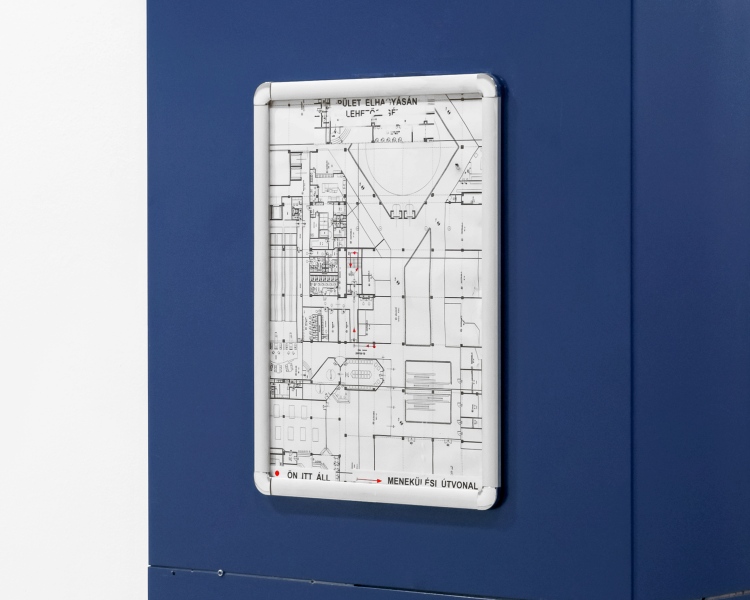
Objects of Gratitude
2015
giclée prints, framed
'Objects of Gratitude' engages with the phenomenon of votive cult in the European tradition. Votive cult or as also called ex-voto cult, is an ancient social and religious phenomenon in many cultures that is usually linked to the popular expressions of piety and belief. 'Ex votos' are offered or given to a saint or to a divinity in gratitude or in a fullfillment of a vow. The cult in Hungary was spread by catholicism in the baroque era when it became the adequate form of thanksgiving. This habit is mostly connected to folk traditions and represent a significant historical, social and religious phenomenon of the culture. Almost everything can serve as votive object, which in this form gets symbolic meanig. Votive churches, chapels, altairs, crosses, statues, but votive plaques, paintings, and the so-called identification objects are also serve the same purpose. It’s material, size and shape testifies financial and social positions. Votive offerings can be also defined as monuments, because they represent and preserve an abstract sense for eternity in a tangible and physical form made by us. Behind their symbolic meaning each one involves the history of a personally experienced joyfull event.

DIY Memorials
Ansel Adams Memorial, 2013
Bohumil Hrabal Memorial, 2013
Plato Memorial, 2013
gilcée prints, framed
50 x 70cm
The aim of building monuments by myself requires quite sober and rational approach. It’s more about a philosophic and accurate process of combining symbols. These memorials only works as an image, untill the time of the exposure lasts, and only from the angle of obejctive. The memorial is the subject of the image and the image also a memorial itself.
Ansel Adams Memorial, 2013
Ansel Adams is a dominant figure in the history of photography. In addition to its technical perfectionism, he has earned his prominent position with the development of the zone system, which means the optimized, coordinated use of the entire reproduction chain, that helps to reproduce the photographic theme in the full range of shades. With the "Ansel Adams Monument" I question this predictability and its learnability, reflecting on the work and role of the American photographer. The starting point is the visualization of the zone system, as it is known from schoolbooks, which is adopted into space as a labile object.
Exhibited:
2018 Hungarian Consulate, New York, US (with Hungary Emerging)
2017 Capture THE Moment: As It Should Be. PDP Conference, Fabrika, Novi Sad, Serbia
2014 FFS booth at ART MARKET BUDAPEST
2014 Hello Your Name Is. Paloma, Budapest
HU
Ansel Adams emlékmű, 2013
Bohumil Hrabal emlékműl, 2013
Platón emlékmű, 2013
giclée nyomatok, keretben
50 x 70cm
Az emlékműállítás egy rendkívűl összetett és felelőségteljes szellemi munka, főleg ha fotografikus úton szeretnénk megvalósítani. A kép esetében minden egyes elem szerepe lényeges, ugyannakkor könnyítés lehet, hogy az emlékműnek csak a fényképezőgép szemszögéből, és csak az expozíció idejéig kell „működnie”.
Kiállítva:
Capture THE Moment: As It Should Be. PDP Conference, Fabrika, Újvidék, Szerbia (2017)
FFS stand, Art Market Budapest (Ansel Adams) (2014)
Hello your name is, Paloma, Budapest ( Bohumil Hrabal) (2014)

Ansel Adams Memorial, 2013
Three Standing Photographers
2012
inkjet prints
"Three Standing Photographers" is an attempt to reveal the operating method of photography in the context of evidence, significance, remembrance and topography.
As usual the documentary practice aims to capture and disclose the yet unnoticed and hidden side of the world, it easily turns against itself by transforming every of its subject into remarkable.
In my work I try to reflect on this pehomenon, documenting apparently insignificant, ordinary places, which inherit their significance from another, archival evidence. For this end, I previously searched for archive photographs which prove the well-known photographer’s exact place at the moment of exposure, and the surface of that place has still remained unchanged, so can be documented as well. From this aspect the endurance of the surface is quite essential, as it is the material that survived (beside the image) so we can take it as a physical and accessible connection between the person and us.
Places can be discovered by the help of coordinates, so they could turn into “unofficial monuments” for personal remembrance.

Installation view at the exhibition 'Nachbilder'. Fotogalerie Wien, 2016 / Photo © Michael Michlmayer
Hungarian Soil
2012
Billboard for the 12. ARC Billboard Exhibition for the topic "Where is abundance?", Budapest
Where is abundance in Hungary? How we can obtain it and how is it differs from earlier routines?
For my work I used Google Earth, the most obvious method of localization. I searched for the country's largest hipermarkets, those roomy pantries, where people have access to a huge amount of food or other household items. This is a different kind of obtaining food, compared to previous routines, where people produced food for themselves. In this self-sufficient society the direct location of plenty was in the soil. Today it differs a bit. In this fictional country map – composed by satellite images – everybody can find the location of his/her daily shopping.
Magyar föld
2012
óriásplakát a 12. ARC kiállításon, a "Jó kedvvel, bőséggel" témára
"Hol található ma Magyarországon Bőség? Hol jutunk ma mindehhez hozzá és ez miben tér el a korábbi megszokástól?
Segítségül a helyhatározás legkézenfekvőbb eszközét használtam: a Google térképpel kerestem meg és fotóztam ki Magyarország nagyobb bevásárlóegységeit, hipermarkettjeit, azokat a mindenhol megtalálható éléskamrákat, ahol egy ország jut az egy helyen, nagy mennyiségben raktározott, megvásárolható élelemhez és egyéb szükséges használati cikkekhez. Ez egy másfajta élelemszerzési módszer mint korábban, amikor az egyének vagy emberközösségek saját magukat látták el a mindennapi élelemmel. Ennek az alapja - és egyben a "Bőség" helye is - a föld volt. Ma ez máshogy van. Az általam kifotózott műholdképekből "felparcellázott" mai Magyarországon mindenki megtalálhatja mindennapi vásárlásának helyszínét."
Kiállítva Exhibited:
"Jó kedvvel, bőséggel” 12. ARC kiállítás
"Where is abundance?" 12. ARC Billboard exhibition
2012. 09. 06-23.
Ötvenhatosok tere, Budapest


































